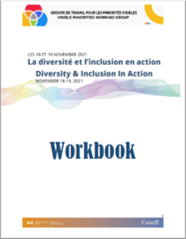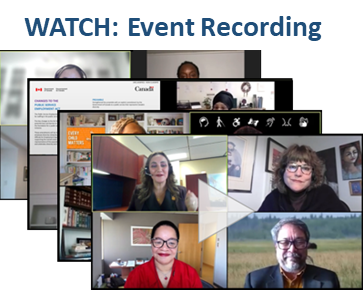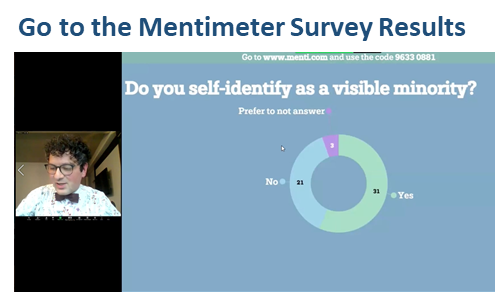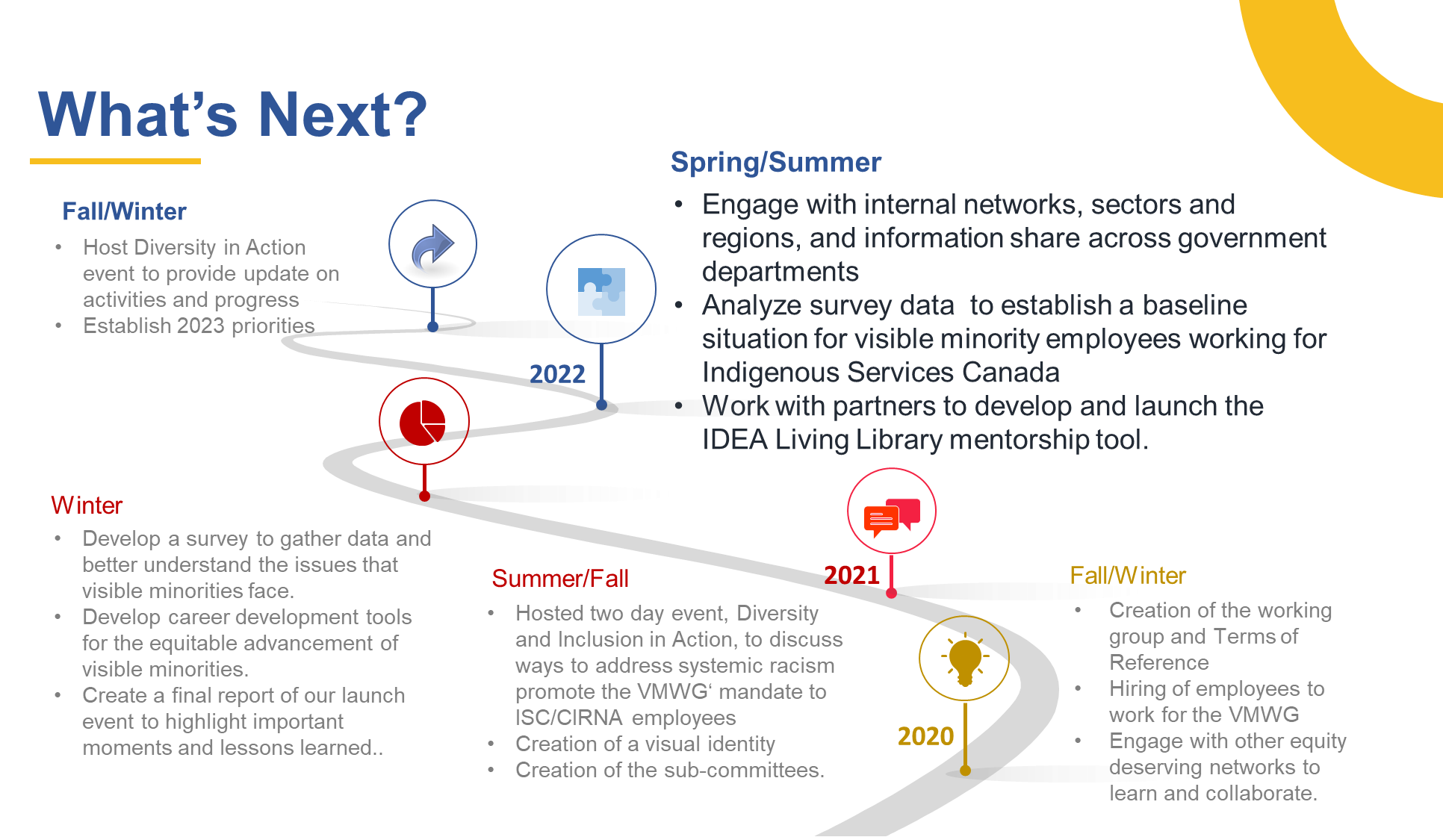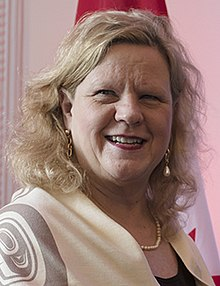2021 Diversité et inclusion en action - Rapport final
En français
EVENT OVERVIEW
Diversity and Inclusion in Action brought together speakers from a range of background and expertise, to discuss how we can begin to move the forward with meaningful and impactful policy that supports all employees in the federal service.
To supplement the information that was shared by our panels, we created a workbook that poses questions to help you think about how you are going to apply the ideas and concepts that have been raised, within your individual teams and larger organizations. There is no expectation that you share the information you record and we hope that this can be a tool to support learning, retention and inspire engagement. Click on the link below to download a copy of the workbook.
Message from Interim Clerk Janice Charette to Diversity and Inclusion in Action attendees
I am pleased to have a chance to contribute to this event, Diversity and Inclusion in Action. I commend you for taking the time to consider how to translate our commitment to anti-racism, equity and inclusion into real, sustainable change. I hope you have found this a valuable opportunity to share promising practices and tools, discuss challenges, and explore different perspectives.
The public service must make progress towards becoming a more welcoming, respectful and supportive culture. Past efforts to strengthen diversity and inclusion within our institutions have not been enough to counter the harmful effects of racism, discrimination and intolerance on groups such as Indigenous Peoples, Black and other racialized people, religious minorities, people with disabilities, and LGBTQ2+ individuals in the public service. This is also true of society in general.
The Clerk, Ian Shugart, formally acknowledged this when he issued the Call to Action on Anti-Racism, Equity, and Inclusion in the Federal Public Service in January. The Call to Action builds on an ecosystem of initiatives in the diversity and inclusion space, as well as years of work of many networks and communities in the federal public service. It also builds on the recommendations in a number of past reports, which resulted from considerable consultations and co-creation. These include the Joint Union/Management Task force on Diversity and Inclusion in the Public Service, the Many Voices One Mind: a Pathway to Reconciliation strategy, and the Accessibility Strategy for the Public Service of Canada.
As part of that call, the Clerk emphasized the need for transparency through open letters reporting departments’ actions and early results. The first round of letters will be posted to the Privy Council Office’s website, and will help show that work is underway and momentum is building.
We are seeing organizations review their policies, guidelines and commitments to anti-racism, equity and inclusion. Departments are launching and engaging with employee networks, anti-racism secretariats, and task forces and working groups like yours to tackle these issues and foster reflection, education and transformation within organizations. This has resulted in actions such as targeted recruitment campaigns to increase representation in the short term, but also initiatives whose impacts extend far into the future.
And this is only a sample of the efforts underway. The work does not and cannot stop there. Our actions must go to further, to the core of how we operate. We must incorporate diverse points of view and experiences and the foundational values of reconciliation into our core business and way of operating, from how we design our business processes to how we develop policies and deliver services to the public. We do this by drawing on diverse set of voices whenever and wherever decisions are made and particularly by amplifying and supporting Indigenous employees and other members of underrepresented communities. I look forward to sharing the analysis of these letters, which will help us determine where real progress is being made, where we can draw further inspiration to accelerate our approach, and where we need to refine or rethink our actions.
This goal of creating a diverse, equitable and inclusive public service, is essential for us to fulfill our core purpose and mandate to serve Canadians and the government. We need to draw on every resource at our disposal. That involves all public servants at all levels, including those in the groups and networks that have long advocated for change.
This brings me back to all of you and your hard work. I would like to sincerely thank you for your dedication and your ongoing efforts to ensure strong Indigenous representation in your respective departments and to create workplaces where diversity is respected and embraced. I invite you to read the letters of other organizations when they have been posted, and think about their contents—both the promising practices shared and the challenges identified. Discuss them with your colleagues and teams and take action. Keep learning and listening to the stories, experiences and perspectives of your colleagues. And keep clearing the path to the full participation of all public servants. Now is the time to address the systemic barriers that limit diversity and inclusion and that have no place in the public service.
I encourage you to join me in continuing the work that will move us closer to the public service Canadians desire, one where everyone feels supported and included. One that reflects the people we serve.
Meegwetch. Nakurmiik. Maarsi. Thank you. Merci.
Janice Charette
Interim Clerk of the Privy Council and Secretary to the Cabinet
Read the full Call to Action on Anti-Racism, Equity, and Inclusion in the Federal Public Service
PANEL DISCUSSIONS (RECORDED)
PANEL 1: DIVERSITY AND INCLUSION IN ACTION
While the need for Diversity and Inclusion policy has become a talking point in the past year, Canada has been legislated to improve public sector workforce diversity since 1995, via the Employment Equity Act. What actions are needed to accelerate this work, and how do we ensure sustainable change that is realized at all levels of the Department?
Panelists:
Daniel Quan-Watson - Deputy Minister of Crown-Indigenous Relations and Northern Affairs, and Champion for Visible Minorities for the Federal Public Service
Christine Donoghue - Chief Human Resources Officer, Treasury Board Secretariat
Dr. Denise O. Green – Vice-President, Equity and Community Inclusion, Ryerson University
Moderated by Kenza, El Bied, Champion for Visible Minorities, Indigenous Services Canada
__________________________________________________________________________________________
PANEL 2: CULTURAL CHANGE
This discussion explored what is at the root of cultural change, and what elements are needed to develop a strategy that promotes meaningful systemic transformation.
Panelists:
Richard Sharpe – Director, Anti-Racism and Anti-Discrimination Secretariat at Justice Canada
Kristy Payne – Chief Operations Officer at Hill + Knowlton Strategies
Anne-Marie Pham - Executive Director at Canadian Centre for Diversity and Inclusion
Moderated by Clara Wong, Visible Minority Working Group
__________________________________________________________________________________________
PANEL 3: CREATING A DIVERSE AND INCLUSIVE WORKPLACE
In the absence of specific goals and a government-wide framework, it is difficult to determine whether current initiatives to strengthen diversity and inclusion are succeeding in reducing or eliminating systemic barriers. How can we leverage existing data and experience to create a Diverse and Inclusive Workplace?
Panelists:
Yazmine Laroche - Deputy Minister, Public Service Accessibility, Treasury Board Secretariat of Canada
Paule-Anny Pierre - Assistant Deputy Minister, Treasury Board of Canada Secretariat
Manju Varma - Commissioner on Systemic Racism for the Government of New Brunswick & Former Senior Advisor, Office of Inclusion, Equity and Anti-racism at Atlantic Canada Opportunities Agency
Moderated by Taiwo Lewis, Visible Minorities Working Group
__________________________________________________________________________________________
PANEL 4: CHANGES IN LEGISLATION, POLICIES & PROGRAMS & THEIR IMPACT
Earlier this year, the Treasury Board announced it is working with Employment and Social Development Canada on the review of the Employment Equity Act “to ensure that the public service applies appropriate benchmarks for diversity.” What kind of targets are supporting this work and what approaches are under consideration?
Panelists:
Gaveen Cadotte – Vice President, Policy and Communications Sector, Public Service Commission of Canada
Selena Beattie - Executive Director of People Management and Community Engagement, Treasury Board of Canada Secretariat
Moderated by Navip-Kaur Singh, Visible Minority Working Group
EVENT SURVEY
TIP: Right click on the image, click 'Open link in a new tab' to display the image file. Click on the image in the new window to zoom in on the results.
SUMMARY
The Diversity in Action 2021 Mentimeter Survey was conducted live on November 18, 2021, and moderated by Working Group Analysis co-lead Ahmad Farhat. The survey posed a series of questions related to employee perceptions of equity and inclusion within Indigenous Services Canada. We have provided the full Mentimeter Survey results in PDF, and invite you to review the candid and thoughtful feedback we received.
**If there are any questions about the methodologies employed to classify and recode results, please don’t hesitate to reach out to the working group at sacchampionminoritevisible-iscvisibleminoritychampion@sac-isc.gc.ca.
General observations by the Visible Minority Working Group analysis team
Question 1. Do you identify as a Visible Minority?
Subgroup Observations
- Attendees were almost evenly split between those who identify as a visible minority and those that do not.
Question 2. How do you distinguish between equality and equity in a professional setting? Do you view them as the same or different?
Subgroup Observations
- Generally very thoughtful and nuanced answers and many demonstrated a strong understanding of how both concepts apply within the workplace.
"Equality essentially means providing everyone with the same amount of resources regardless of whether everyone needs them. ... Equity is when resources are shared based on what each person needs in order to adequately level the playing field." Equity vs Equality: What’s the Difference? (globalcitizen.org)
Question 3. How does Indigenous Services Canada measure up on ensuring an equal/equitable workplace?
Subgroup Observations
- Generally a relatively tepid tone towards the Department’s performance in fostering an equitable workspace
- Many respondents noted that while the Department is diverse in its makeup, it is falling short on issues of equity
- A number of respondents made a distinction between advancement opportunities for Indigenous employees versus those offered to visible minorities, and cited a need for greater Indigenous representation at senior levels of management.
Question 4. Please speak to your personal perspective on recruitment, retention and career advancement.
Subgroup Observations
- Fairly balanced response that reflects the results from question 2
- Respondents did not necessarily perceive hiring as the problem, more so retention.
Question 5. What actions do you see the Visible Minority Working Group taking to advance equity within our workplace?
Subgroup Observations
- The mean and median skewed lower than question 3 as we do know that retention and career advancement are the larger challenges, though it was noted that the average still skewed relatively neutral. Just shy of half of respondents were non visible minorities, which could explain that outcome.
.
Question 6. What do you think management should do to promote retention of diverse employees?
Subgroup Observations
- This question yielded mixed results as many respondents were unsure how to answer
- Responses identified the need for the greater clarity and communication on the mandate and mission statement of the Visible Minority Working Group
- The subgroup also considered that the way the question was worded may have lead to confusion
- Responses that fell within the Working Group's scope of work focused on hiring, retention of visible minorities and training for supervisors and senior managers.
NEXT STEPS
CONCLUSION
This two day event brought together thought leaders in the Diversity and Inclusion space including senior officials in the public and private sector and academia. Topics and themes discussed were timely and relevant given growing momentum to address systems of oppression that impact the places we live and work today. We were grateful for the incredible contributions of passionate speakers during our panel discussions.
" ISC has dedicated members of the Visible Minority Working Group who really helped to make the event come together and run smoothly. I feel privileged to work in a Department that values our diverse voices and thoughts and creates spaces for us to continue important discussions." - Clara Wong, Launch Event Lead
This final report will help the Visible Minority Working Group set priorities into the future.
In 2022, Working Group members are particularly focused on engaging with partners internally and across government to develop our mentorship tools. We are also conducting a survey to gain an understanding of the priorities for visible minority employees in Indigenous Services Canada and set priorities into the future. We are launching our Podcast series which will discuss areas of interest within the D&I space through a visible minority lens, and later in the year, we will be summarizing lessons learned from this year in a final report.
Special thanks to the Launch Event Team who helped make this event an incredible success:

